Variations in the Home Language Environment and Early Language Development in Rural China
Abstract
1. Introduction
2. Materials and Methods
2.1. Sample Selection
2.2. Measures
2.2.1. Home Language Environment: LENA
2.2.2. Child Language Skills and Demographic Information
2.3. Statistical Analysis
3. Results
4. Discussion
5. Conclusions
Author Contributions
Funding
Institutional Review Board Statement
Informed Consent Statement
Acknowledgments
Conflicts of Interest
References
- Gilkerson, J.; Richards, J.A.; Warren, S.F.; Oller, D.K.; Russo, R.; Vohr, B. Language Experience in the Second Year of Life and Language Outcomes in Late Childhood. Pediatrics 2018, 142. [Google Scholar] [CrossRef]
- Weisleder, A.; Fernald, A. Talking to Children Matters: Early Language Experience Strengthens Processing and Builds Vocabulary. Psychol. Sci. 2013, 24, 2143–2152. [Google Scholar] [CrossRef] [PubMed]
- Ramírez-Esparza, N.; García-Sierra, A.; Kuhl, P.K. Look Who’s Talking: Speech Style and Social Context in Language Input to Infants Are Linked to Concurrent and Future Speech Development. Dev. Sci. 2014, 17, 880–891. [Google Scholar] [CrossRef] [PubMed]
- Hart, B.; Risley, T.R. Meaningful Differences in the Everyday Experience of Young American Children; Paul H Brookes Publishing: Baltimore, MD, USA, 1995; p. 268. ISBN 978-1-55766-197-5. [Google Scholar]
- Gilkerson, J.; Richards, J.A. Impact of Adult Talk, Conversational Turns, and TV during the Critical 0–4 Years of Child Development; LENA Foundation: Boulder, CO, USA, 2010. [Google Scholar]
- Hurtado, N.; Grüter, T.; Marchman, V.; Fernald, A. Relative Language Exposure, Processing Efficiency and Vocabulary in Spanish–English Bilingual Toddlers*. Biling. Lang. Cogn. 2013. [Google Scholar] [CrossRef]
- Lee, V.E.; Burkam, D.T. Inequality at the Starting Gate: Social Background Differences in Achievement as Children Begin School; Economic Policy Institute: Washington, DC, USA, 2002; ISBN 978-1-932066-02-9. [Google Scholar]
- Fernald, A.; Marchman, V.A.; Weisleder, A. SES Differences in Language Processing Skill and Vocabulary Are Evident at 18 Months. Dev. Sci. 2013, 16, 234–248. [Google Scholar] [CrossRef]
- Rowe, M.L. A Longitudinal Investigation of the Role of Quantity and Quality of Child-Directed Speech in Vocabulary Development. Child. Dev. 2012, 83, 1762–1774. [Google Scholar] [CrossRef]
- Hirsh-Pasek, K.; Adamson, L.B.; Bakeman, R.; Owen, M.T.; Golinkoff, R.M.; Pace, A.; Yust, P.K.S.; Suma, K. The Contribution of Early Communication Quality to Low-Income Children’s Language Success. Psychol. Sci. 2015, 26, 1071–1083. [Google Scholar] [CrossRef] [PubMed]
- Ganek, H.; Eriks-Brophy, A. Language ENvironment Analysis (LENA) System Investigation of Day Long Recordings in Children: A Literature Review. J. Commun. Disord. 2018, 72, 77–85. [Google Scholar] [CrossRef]
- Ramírez, N.F.; Lytle, S.R.; Kuhl, P.K. Parent Coaching Increases Conversational Turns and Advances Infant Language Development. PNAS 2020, 117, 3484–3491. [Google Scholar] [CrossRef] [PubMed]
- Rowe, M.L. Child-Directed Speech: Relation to Socioeconomic Status, Knowledge of Child Development and Child Vocabulary Skill. J. Child. Lang. 2008, 35, 185–205. [Google Scholar] [CrossRef]
- Wood, C.; Diehm, E.A.; Callender, M.F. An Investigation of Language Environment Analysis Measures for Spanish–English Bilingual Preschoolers from Migrant Low-Socioeconomic-Status Backgrounds. Lang. Speech Hear. Serv. Sch. 2016, 47, 123–134. [Google Scholar] [CrossRef] [PubMed]
- Hurtado, N.; Marchman, V.A.; Fernald, A. Does Input Influence Uptake? Links between Maternal Talk, Processing Speed and Vocabulary Size in Spanish-Learning Children. Dev. Sci. 2008, 11, F31–F39. [Google Scholar] [CrossRef] [PubMed]
- Ramey, C.T.; Ramey, S.L. Early Learning and School Readiness: Can Early Intervention Make a Difference? Merrill-Palmer Q. 2004, 50, 471–491. [Google Scholar] [CrossRef]
- Wang, Y.; Hartman, M.; Aziz, N.A.A.; Arora, S.; Shi, L.; Tunison, E. A Systematic Review of the Use of LENA Technology. Am. Ann. Deaf 2017, 162, 295–311. [Google Scholar] [CrossRef] [PubMed]
- Zhang, Y.; Xu, X.; Jiang, F.; Gilkerson, J.; Xu, D.; Richards, J.A.; Harnsberger, J.; Topping, K.J. Effects of Quantitative Linguistic Feedback to Caregivers of Young Children: A Pilot Study in China. Commun. Disord. Q. 2015, 37, 16–24. [Google Scholar] [CrossRef]
- Pae, S.; Yoon, H.; Seol, A.; Gilkerson, J.; Richards, J.A.; Ma, L.; Topping, K. Effects of Feedback on Parent–Child Language with Infants and Toddlers in Korea. First Lang. 2016, 36, 549–569. [Google Scholar] [CrossRef]
- Weber, A.; Fernald, A.; Diop, Y. When Cultural Norms Discourage Talking to Babies: Effectiveness of a Parenting Program in Rural Senegal. Child. Dev. 2017, 88, 1513–1526. [Google Scholar] [CrossRef]
- Casillas, M.; Brown, P.; Levinson, S.C. Early Language Experience in a Tseltal Mayan Village. Child. Dev. 2020, 91, 1819–1835. [Google Scholar] [CrossRef]
- Hamadani, J.D.; Tofail, F.; Hilaly, A.; Huda, S.N.; Engle, P.; Grantham-McGregor, S.M. Use of Family Care Indicators and Their Relationship with Child Development in Bangladesh. J. Health Popul. Nutr. 2010, 28, 23–33. [Google Scholar] [CrossRef] [PubMed]
- Luo, R.; Jia, F.; Yue, A.; Zhang, L.; Lyu, Q.; Shi, Y.; Yang, M.; Medina, A.; Kotb, S.; Rozelle, S. Passive Parenting and Its Association with Early Child Development. Early Child. Dev. Care 2019, 189, 1709–1723. [Google Scholar] [CrossRef]
- Yue, A.; Shi, Y.; Luo, R.; Chen, J.; Garth, J.; Zhang, J.; Medina, A.; Kotb, S.; Rozelle, S. China’s Invisible Crisis: Cognitive Delays among Rural Toddlers and the Absence of Modern Parenting. China J. 2017, 78, 50–80. [Google Scholar] [CrossRef]
- Wang, L.; Liang, W.; Zhang, S.; Jonsson, L.; Li, M.; Yu, C.; Sun, Y.; Ma, Q.; Bai, Y.; Abbey, C.; et al. Are Infant/Toddler Developmental Delays a Problem across Rural China? J. Comp. Econ. 2019, 47, 458–469. [Google Scholar] [CrossRef]
- Black, M.M.; Walker, S.P.; Fernald, L.C.H.; Andersen, C.T.; DiGirolamo, A.M.; Lu, C.; McCoy, D.C.; Fink, G.; Shawar, Y.R.; Shiffman, J.; et al. Early Childhood Development Coming of Age: Science through the Life Course. Lancet 2017, 389, 77–90. [Google Scholar] [CrossRef]
- Bornstein, M.H.; Putnick, D.L. Cognitive and Socioemotional Caregiving in Developing Countries. Child. Dev. 2012, 83, 46–61. [Google Scholar] [CrossRef]
- China National Bureau of Statistics. China Statistical Yearbook; China Statistics Press: Beijing, China, 2015. [Google Scholar]
- Zhou, B.; Liu, W.; Lu, W.; Zhao, M.; Li, L. Application of OECD LSE Framework to Assess Spatial Differences in Rural Green Development in the Arid Shaanxi Province, China. Int. J. Environ. Res. Public Health 2020, 17, 286. [Google Scholar] [CrossRef]
- Ford, M.; Baer, C.T.; Xu, D.; Yapanel, U.; Gray, S. The LENATM Language Environment Analysis System: Audio Specifications of the DLP-0121; LENA Foundation: Boulder, CO, USA, 2008. [Google Scholar]
- Gilkerson, J.; Richards, J.A. The LENATM Developmental Snapshot; LENA Foundation: Boulder, CO, USA, 2008. [Google Scholar]
- Xu, D.; Yapanel, U.; Gray, S. Reliability of the LΕΝΑTM Language Environment Analysis System in Young Children’s Natural Language Home Environment; LENA Foundation: Boulder, CO, USA, 2009. [Google Scholar]
- Gilkerson, J.; Zhang, Y.; Xu, D.; Richards, J.A.; Xu, X.; Jiang, F.; Harnsberger, J.; Topping, K. Evaluating Language Environment Analysis System Performance for Chinese: A Pilot Study in Shanghai. J. Speech Lang. Hear. Res. 2015, 58, 445–452. [Google Scholar] [CrossRef]
- Busch, T.; Sangen, A.; Vanpoucke, F.; van Wieringen, A. Correlation and Agreement between Language ENvironment Analysis (LenaTM) and Manual Transcription for Dutch Natural Language Recordings. Behav. Res. 2018, 50, 1921–1932. [Google Scholar] [CrossRef]
- Schwarz, I.-C.; Botros, N.; Lord, A.; Marcusson, A.; Tidelius, H.; Marklund, E. The LENATM System Applied to Swedish: Reliability of the Adult Word Count Estimate; The International Speech Communication Association (ISCA): Baixas, France, 2017; pp. 2088–2092. [Google Scholar]
- Ganek, H.V.; Eriks-Brophy, A. A Concise Protocol for the Validation of Language ENvironment Analysis (LENA) Conversational Turn Counts in Vietnamese. Commun. Disord. Q. 2018, 39, 371–380. [Google Scholar] [CrossRef]
- Caskey, M.; Stephens, B.; Tucker, R.; Vohr, B. Importance of Parent Talk on the Development of Preterm Infant Vocalizations. Pediatrics 2011, 128, 910–916. [Google Scholar] [CrossRef]
- Wiggin, M.; Gabbard, S.; Thompson, N.; Goberis, D.; Yoshinaga-Itano, C. The School to Home Link: Summer Preschool and Parents. Semin Speech Lang. 2012, 33, 290–296. [Google Scholar] [CrossRef]
- Oller, D.K.; Niyogi, P.; Gray, S.; Richards, J.A.; Gilkerson, J.; Xu, D.; Yapanel, U.; Warren, S.F. Automated Vocal Analysis of Naturalistic Recordings from Children with Autism, Language Delay, and Typical Development. PNAS 2010, 107, 13354–13359. [Google Scholar] [CrossRef] [PubMed]
- Fenson, L.; Marchman, V.A.; Thal, D.J.; Dale, P.S.; Reznick, S.; Bates, E. MacArthur-Bates Communicative Development Inventories; Paul H Brookes Publishing Company: Baltimore, MD, USA, 2007; ISBN 978-1-55766-884-4. [Google Scholar]
- Tardif, T.; Fletcher, P.; Zhang, Z.X.; Liang, W.L.; Zuo, Q.H.; Chen, P. User’s Guide and Manual for the Chinese Communicative Development Inventories (Putonghua and Cantonese); Peking University Medical Press: Beijing, China, 2008. [Google Scholar]
- Hoff, E. How Social Contexts Support and Shape Language Development. Dev. Rev. 2006, 26, 55–88. [Google Scholar] [CrossRef]
- Kolenikov, S.; Angeles, G. Socioeconomic Status Measurement with Discrete Proxy Variables: Is Principal Component Analysis a Reliable Answer? Rev. Income Wealth 2009, 55, 128–165. [Google Scholar] [CrossRef]
- McCartney, K. Effect of Quality of Day Care Environment on Children’s Language Development. Dev. Psychol. 1984, 20, 244–260. [Google Scholar] [CrossRef]
- Mayor, J.; Arias-Trejo, N.; Alva, E.A. The Impact of Household Size on Lexical Typicality: An Early Link Between Language and Social Cognition? Front. Psychol. 2018, 9. [Google Scholar] [CrossRef] [PubMed]
- Greenwood, C.R.; Thiemann-Bourque, K.; Walker, D.; Buzhardt, J.; Gilkerson, J. Assessing Children’s Home Language Environments Using Automatic Speech Recognition Technology. Commun. Disord. Q. 2011, 32, 83–92. [Google Scholar] [CrossRef]
- Suskind, D.L.; Leffel, K.R.; Graf, E.; Hernandez, M.W.; Gunderson, E.A.; Sapolich, S.G.; Suskind, E.; Leininger, L.; Goldin-Meadow, S.; Levine, S.C. A Parent-Directed Language Intervention for Children of Low Socioeconomic Status: A Randomized Controlled Pilot Study*. J. Child. Lang. 2016, 43, 366–406. [Google Scholar] [CrossRef]
- Lonigan, C.J.; Burgess, S.R.; Anthony, J.L. Development of Emergent Literacy and Early Reading Skills in Preschool Children: Evidence from a Latent-Variable Longitudinal Study. Dev. Psychol. 2000, 36, 596–613. [Google Scholar] [CrossRef] [PubMed]
- Suskind, D.; Leffel, K.R.; Hernandez, M.W.; Sapolich, S.G.; Suskind, E.; Kirkham, E.; Meehan, P. An Exploratory Study of “Quantitative Linguistic Feedback”: Effect of LENA Feedback on Adult Language Production. Commun. Disord. Q. 2013, 34, 199–209. [Google Scholar] [CrossRef]
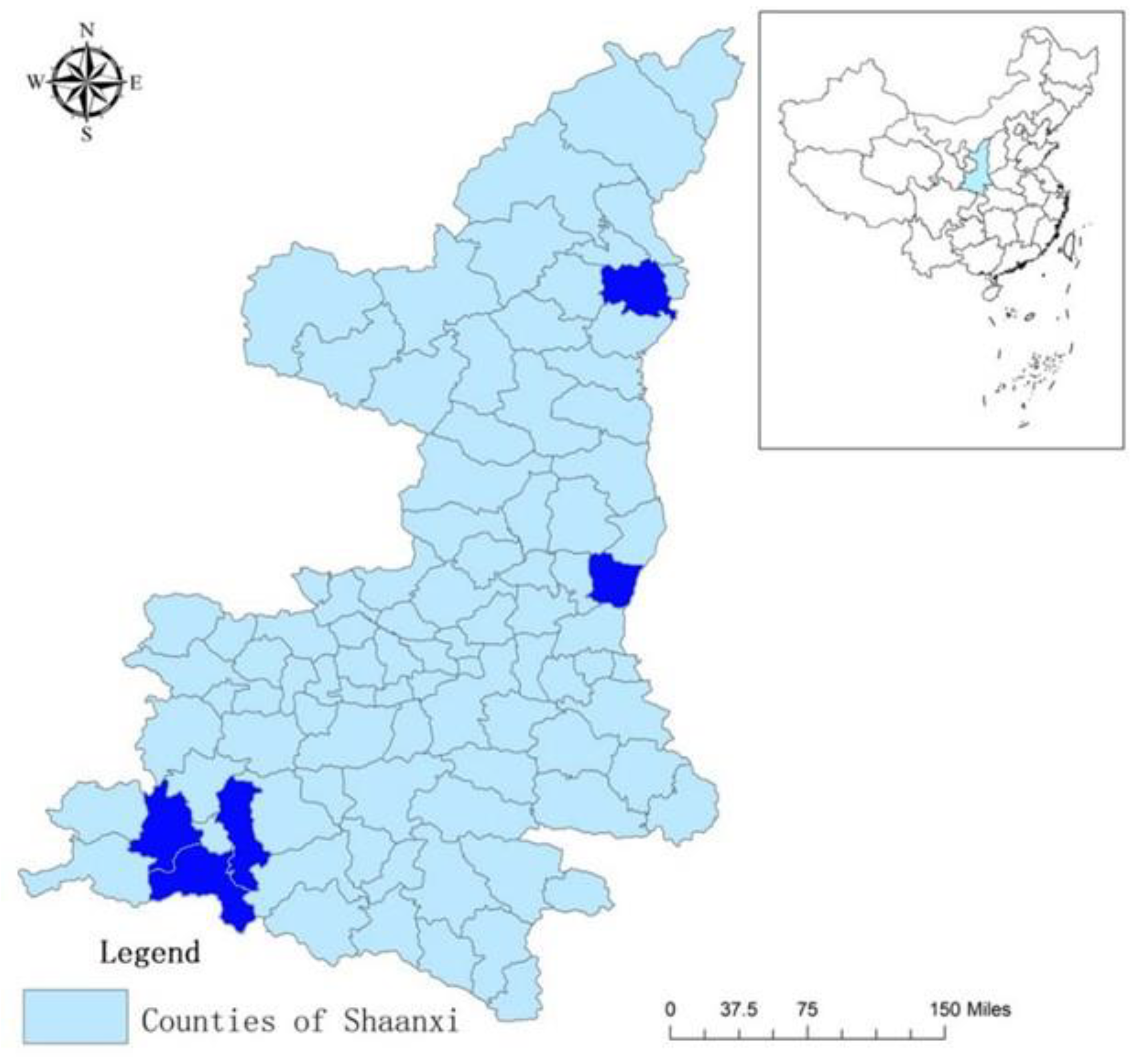
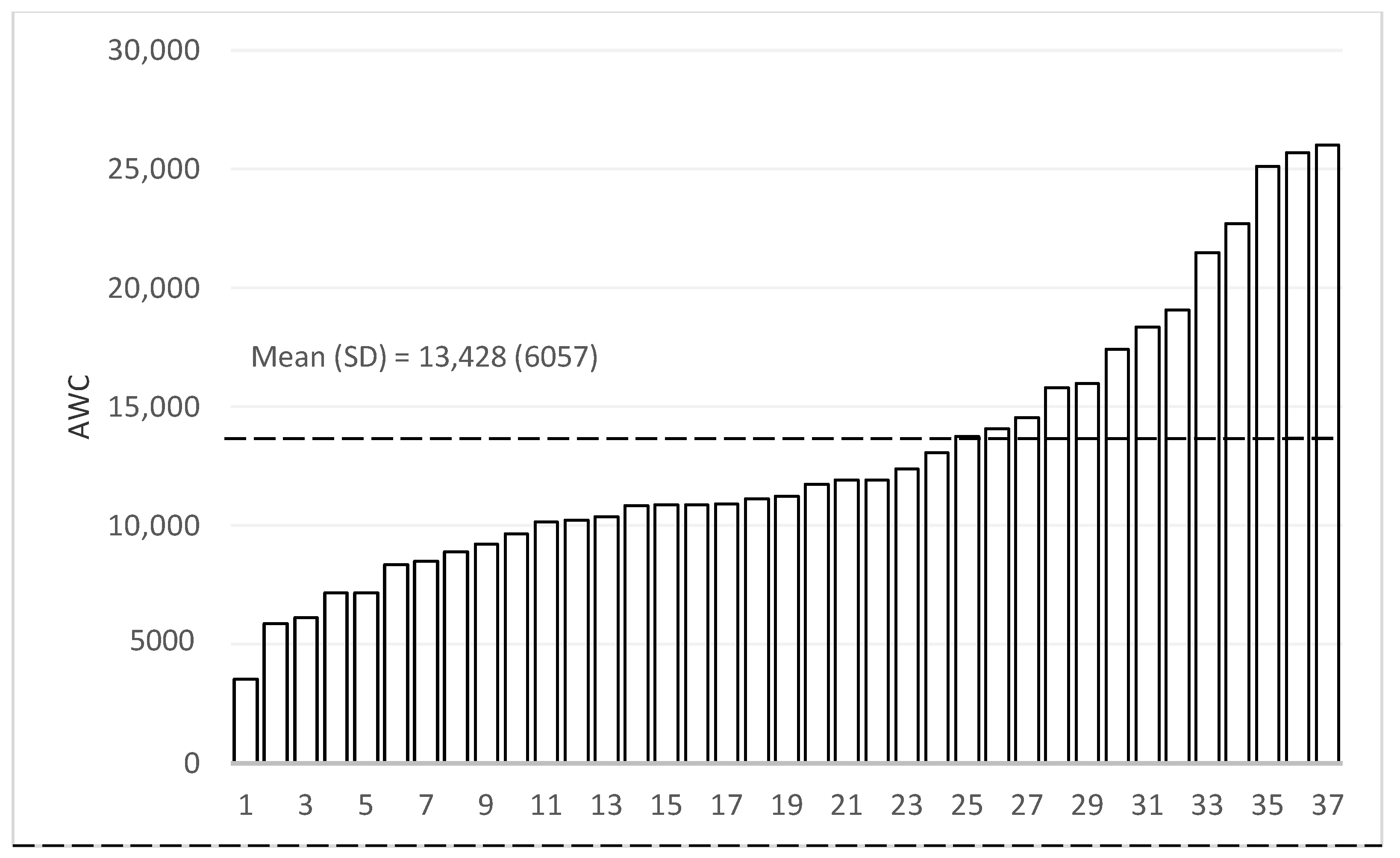
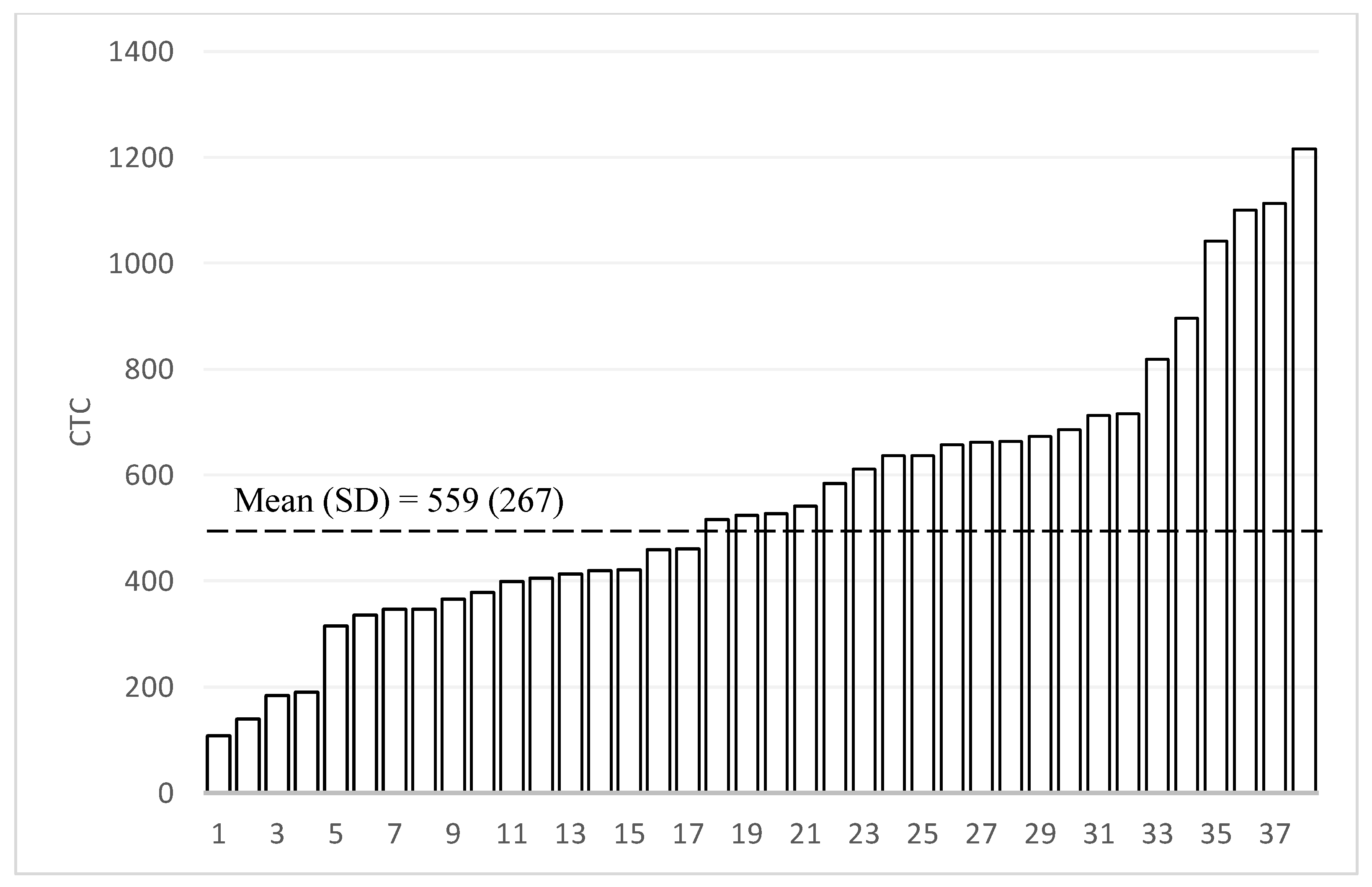
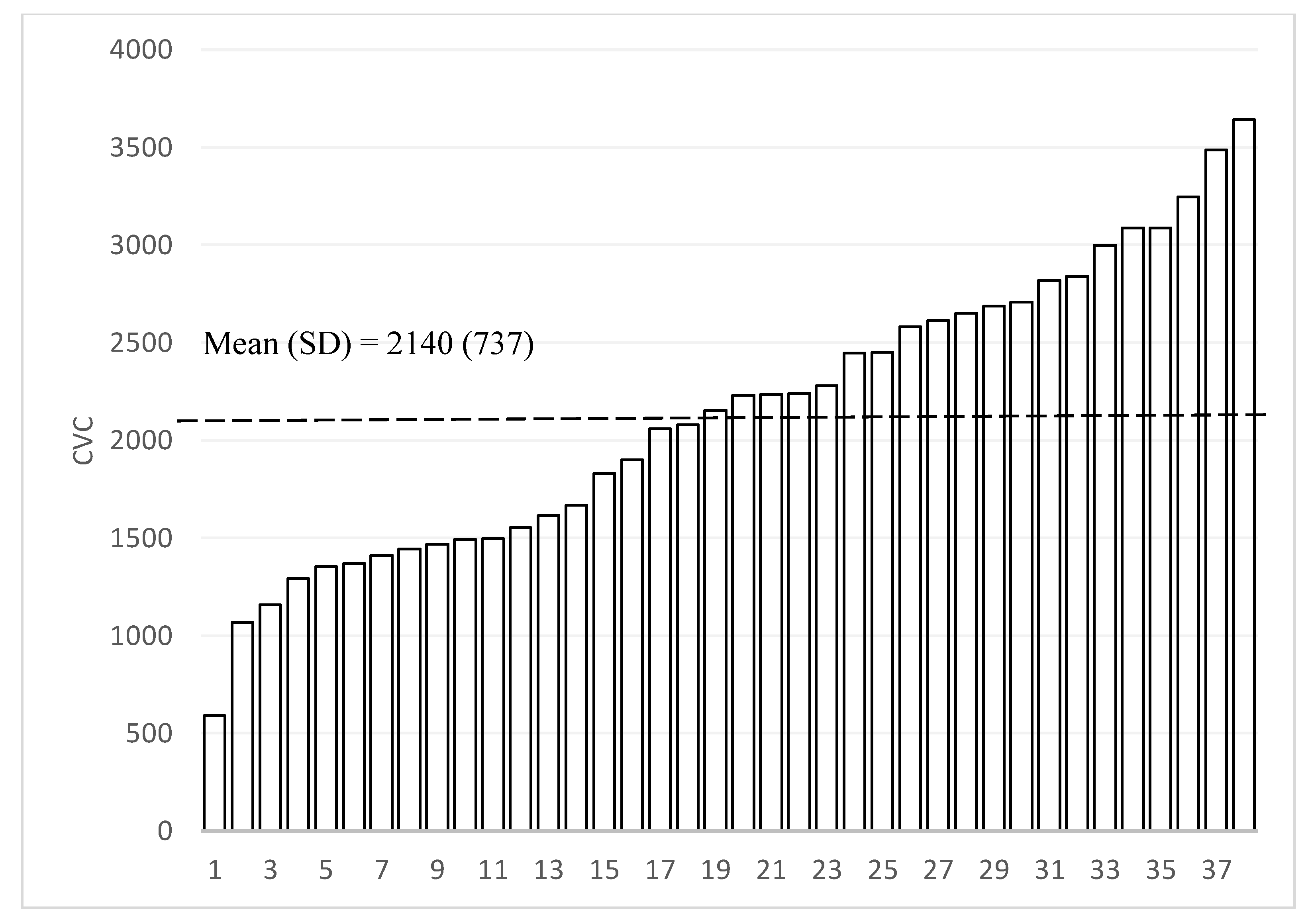
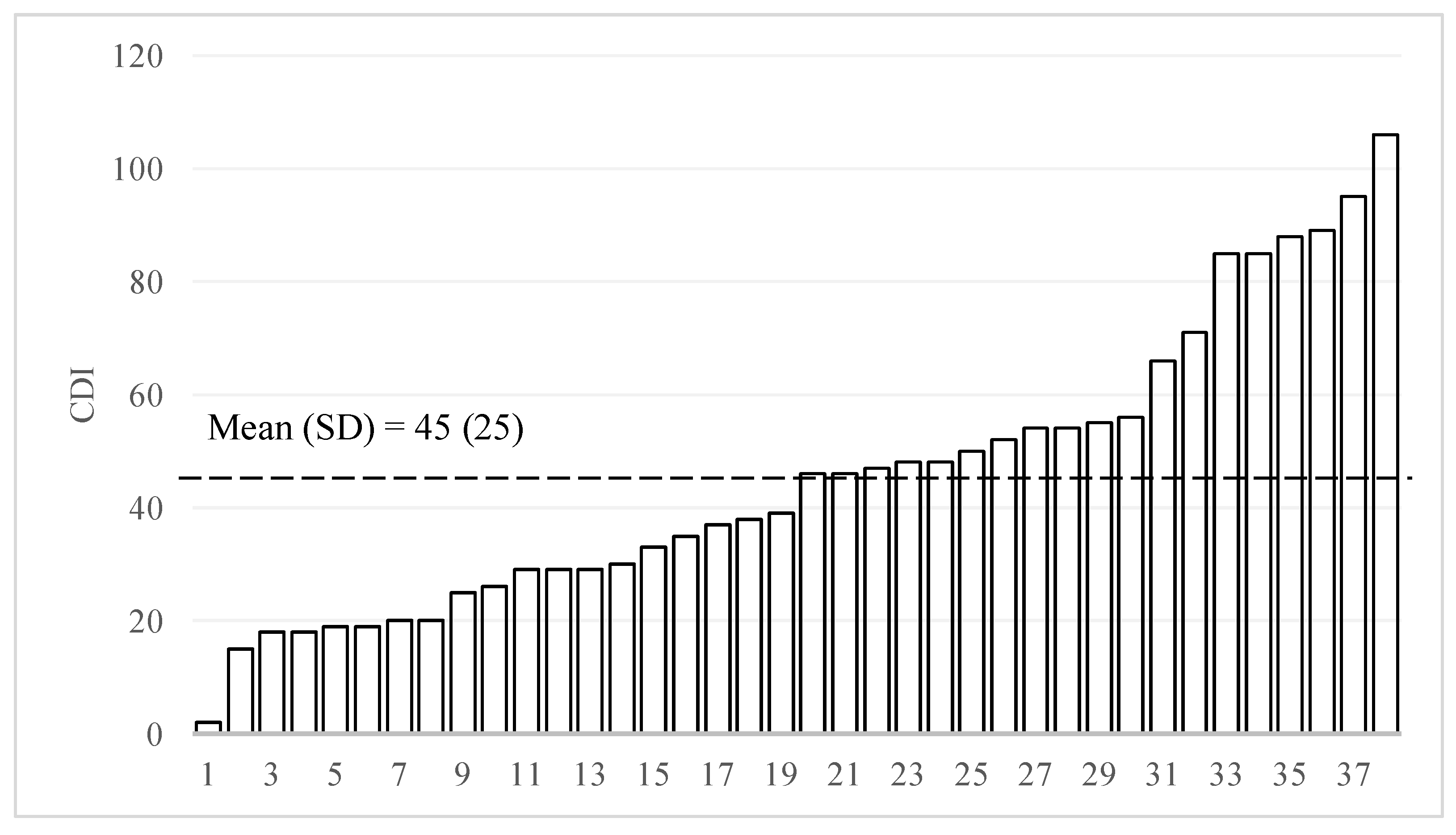

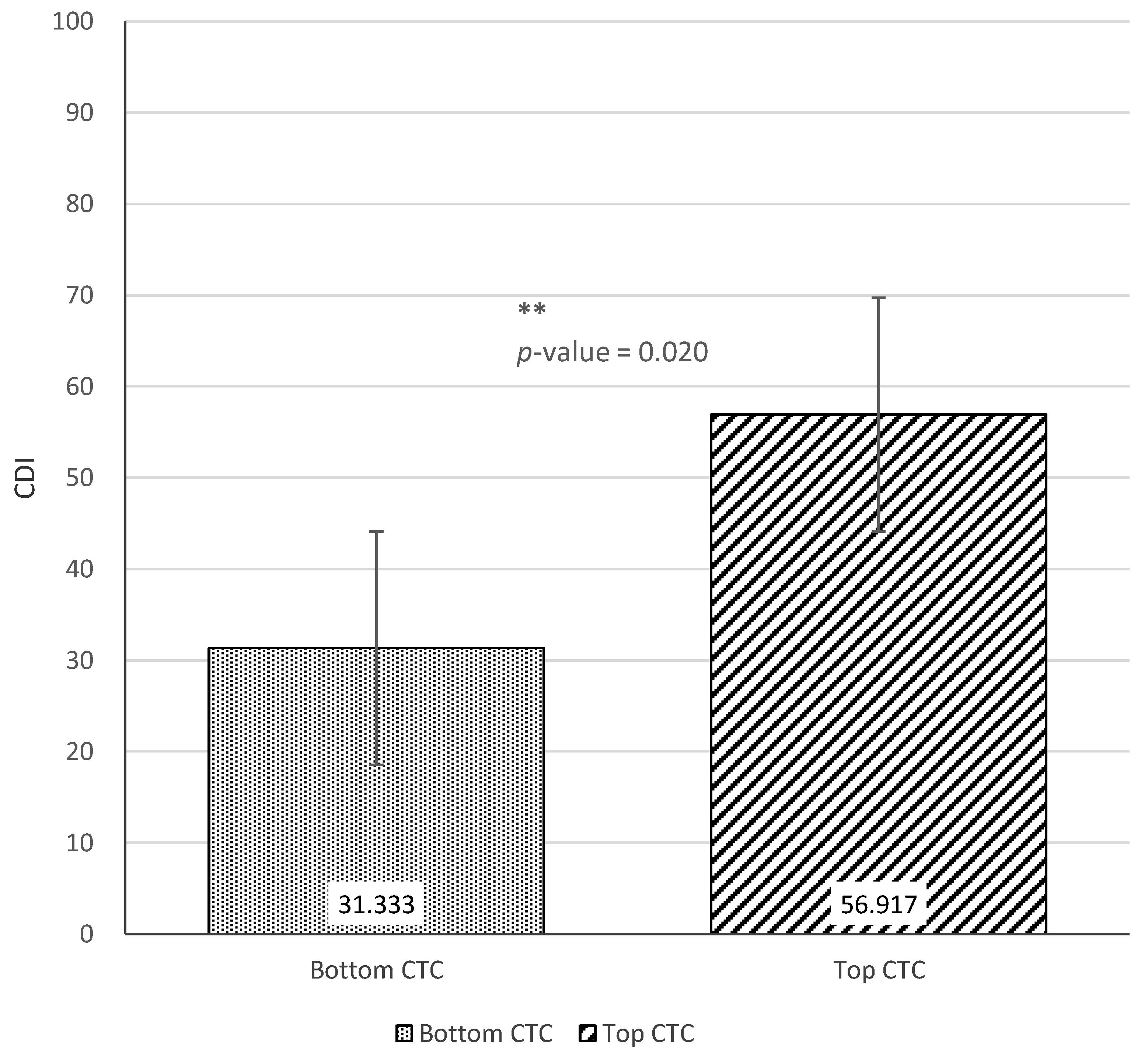
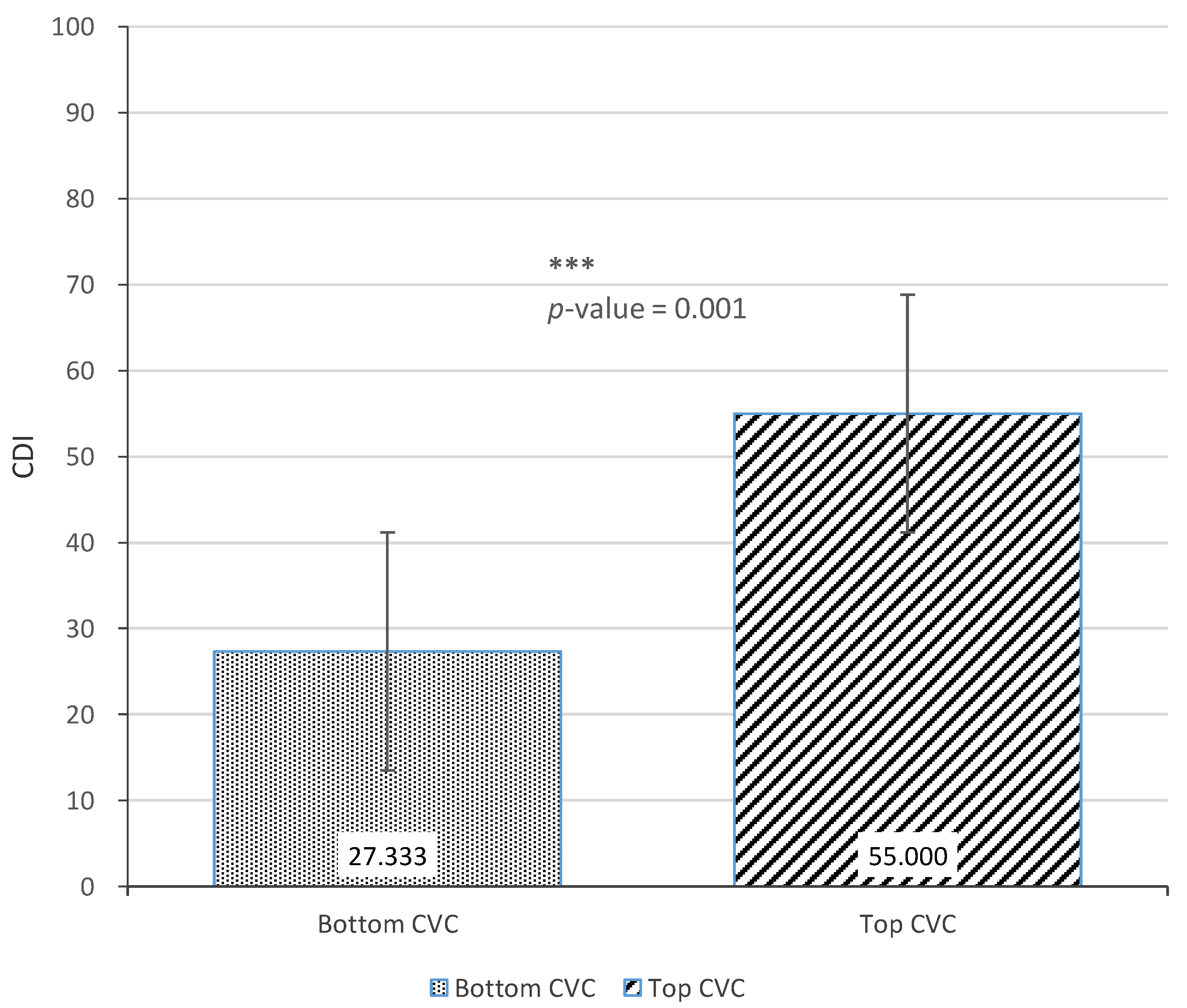
| Variables | Frequency/Mean (N = 38) |
|---|---|
| Child characteristics | |
| Age, months, Mean (SD) | 24.58 (2.07) |
| Male, n (%) | 20 (52.63) |
| Premature, n (%) | 4 (10.53) |
| Household characteristics | |
| Age of mother, years, Mean (SD) | 28.76 (3.66) |
| Mother completed middle school or above, n (%) | 8 (21.05) |
| Mother is primary caregiver, n (%) | 28 (73.68) |
| Number of adults in household, Mean (SD) | 2.08 (1.08) |
| Number of siblings in household, Mean (SD) | 0.26 (0.45) |
| Father completed middle school or above, n (%) | 4 (10.53) |
| Father lived at home during most of last year, n (%) | 24 (63.16) |
| Asset index (PCA score), Mean (SD) | 0.00 (1.77) |
| Variables | Bottom ⅓ of AWC | Top ⅓ of AWC | Difference |
|---|---|---|---|
| (1) | (2) | (3) = (2) − (1) | |
| Child characteristics | |||
| Age (months) | 24.885 | 23.775 | −1.110 |
| (2.225) | (2.024) | (0.853) | |
| Gender (1 = boy) | 0.385 | 0.500 | 0.115 |
| (0.506) | (0.522) | (0.206) | |
| Prematurity (1 = yes) | 0.154 | 0.000 | −0.154 |
| (0.376) | (0.000) | (0.109) | |
| Household characteristics | |||
| Age of Mother (years) | 27.615 | 30.000 | 2.385 |
| (3.595) | (4.134) | (1.546) | |
| Maternal education (1 = completed high school or above) | 0.308 | 0.167 | −0.141 |
| (0.480) | (0.389) | (0.176) | |
| Mother is primary caregiver (1 = yes) | 0.692 | 0.667 | −0.026 |
| (0.480) | (0.492) | (0.195) | |
| Paternal education (1 = completed high school or above) | 0.077 | 0.167 | 0.090 |
| (0.277) | (0.389) | (0.134) | |
| Father lived at home during most of last year (1 = yes) | 0.769 | 0.667 | −0.103 |
| (0.439) | (0.492) | (0.186) | |
| Asset index (PCA score) | 0.109 | −0.533 | −0.642 |
| (2.168) | (1.399) | (0.737) | |
| Number of adults in the household | 1.923 | 2.167 | 0.244 |
| (1.188) | (1.193) | (0.477) | |
| Number of siblings at home | 0.308 | 0.250 | −0.058 |
| (0.480) | (0.452) | (0.187) |
| Variables | Bottom ⅓ of CTC | Top ⅓ of CTC | Difference |
|---|---|---|---|
| (1) | (2) | (3) = (2) − (1) | |
| Child characteristics | |||
| Age (months) | 24.686 | 24.336 | −0.350 |
| (2.325) | (1.907) | (0.868) | |
| Gender (1 = boy) | 0.333 | 0.667 | 0.333 |
| (0.492) | (0.492) | (0.201) | |
| Prematurity (1 = yes) | 0.083 | 0.083 | −0.000 |
| (0.289) | (0.289) | (0.118) | |
| Household characteristics | |||
| Age of Mother (years) | 26.833 | 29.417 | 2.583 * |
| (3.460) | (3.288) | (1.378) | |
| Maternal education (1 = completed high school or above) | 0.250 | 0.250 | 0.000 |
| (0.452) | (0.452) | (0.185) | |
| Mother is primary caregiver (1 = yes) | 0.750 | 0.750 | 0.000 |
| (0.452) | (0.452) | (0.185) | |
| Paternal education (1 = completed high school or above) | 0.000 | 0.167 | 0.167 |
| (0.000) | (0.389) | (0.112) | |
| Father lived at home during most of last year (1 = yes) | 0.750 | 0.750 | 0.000 |
| (0.452) | (0.452) | (0.185) | |
| Asset index (PCA score) | 0.007 | 0.059 | 0.052 |
| (2.132) | (1.615) | (0.772) | |
| Number of adults in the household | 2.083 | 2.333 | 0.250 |
| (1.084) | (1.073) | (0.440) | |
| Number of siblings at home | 0.333 | 0.167 | −0.167 |
| (0.492) | (0.389) | (0.181) |
| Variables | Bottom ⅓ of CVC | Top ⅓ of CVC | Difference |
|---|---|---|---|
| (1) | (2) | (3) = (2) − (1) | |
| Child characteristics | |||
| Age (months) | 24.183 | 24.656 | 0.473 |
| (2.168) | (2.041) | (0.842) | |
| Gender (1 = boy) | 0.500 | 0.615 | 0.115 |
| (0.522) | (0.506) | (0.206) | |
| Prematurity (1 = yes) | 0.083 | 0.154 | 0.071 |
| (0.289) | (0.376) | (0.135) | |
| Household characteristics | |||
| Age of Mother (years) | 28.667 | 28.923 | 0.256 |
| (4.519) | (3.121) | (1.543) | |
| Maternal education (1 = completed high school or above) | 0.167 | 0.308 | 0.141 |
| (0.389) | (0.480) | (0.176) | |
| Mother is primary caregiver (1 = yes) | 0.833 | 0.692 | −0.141 |
| (0.389) | (0.480) | (0.176) | |
| Paternal education (1 = completed high school or above) | 0.000 | 0.231 | 0.231 * |
| (0.000) | (0.439) | (0.127) | |
| Father lived at home during most of last year (1 = yes) | 0.833 | 0.692 | −0.141 |
| (0.389) | (0.480) | (0.176) | |
| Asset index (PCA score) | −0.445 | 0.407 | 0.852 |
| (1.759) | (1.780) | (0.709) | |
| Number of adults in the household | 1.833 | 2.308 | 0.474 |
| (1.115) | (1.182) | (0.461) | |
| Number of siblings at home | 0.500 | 0.154 | −0.346 * |
| (0.522) | (0.376) | (0.181) |
| Variables | AWC | CTC | CVC |
|---|---|---|---|
| (1) | (2) | (3) | |
| Child characteristics | |||
| Age (months) | −125.62 | 0.49 | 82.37 |
| (649.88) | (26.15) | (79.87) | |
| Gender (1 = boy) | 241.00 | −5.90 | 23.24 |
| (2778.50) | (111.79) | (341.47) | |
| Prematurity (1 = yes) | −2915.19 | −36.08 | 387.04 |
| (4267.58) | (171.70) | (524.47) | |
| Household characteristics | |||
| Age of Mother (years) | 288.76 | 34.10 ** | 60.32 |
| (401.61) | (16.16) | (49.36) | |
| Maternal education (1 = completed high school or above) | −1477.58 | −94.30 | −164.36 |
| (3487.68) | (140.32) | (428.62) | |
| Mother is primary caregiver (1 = yes) | −4695.00 | −157.14 | 100.65 |
| (3200.18) | (128.75) | (393.29) | |
| Paternal education (1 = completed high school or above) | 4282.59 | 189.33 | 253.99 |
| (5017.59) | (201.87) | (616.64) | |
| Father lived at home during most of last year (1 = yes) | −401.06 | 92.82 | 254.68 |
| (2723.92) | (109.59) | (334.76) | |
| Asset index (PCA score) | 98.85 | 45.04 | 24.04 |
| (1079.30) | (43.42) | (132.64) | |
| Number of adults in the household | 2,172.71 | 64.63 | 93.74 |
| (1499.87) | (60.34) | (184.33) | |
| Number of siblings at home | −2770.30 | −292.05 * | −619.62 |
| (3572.16) | (143.72) | (439.00) | |
| Observations | 38 | 38 | 38 |
| R-squared | 0.34 | 0.45 | 0.32 |
| Variables | AWC | CTC | CVC |
|---|---|---|---|
| (1) | (2) | (3) | |
| Home Language Environment Measures | |||
| AWC | 0.00 | ||
| (0.00) | |||
| CTC | 0.03 ** | ||
| (0.02) | |||
| CVC | 0.01 * | ||
| (0.01) | |||
| Child characteristics | |||
| Age (months) | 1.54 | 1.48 | 0.72 |
| (2.08) | (1.87) | (1.99) | |
| Gender (1 = boy) | −4.93 | −4.63 | −5.06 |
| (8.87) | (7.99) | (8.30) | |
| Prematurity (1 = yes) | −25.46 * | −25.29 * | −30.20 ** |
| (13.76) | (12.29) | (12.91) | |
| Household characteristics | |||
| Age of Mother (years) | 3.22 ** | 2.14 | 2.76 ** |
| (1.30) | (1.27) | (1.24) | |
| Maternal education (1 = completed high school or above) | 22.96 * | 25.69 ** | 23.96 ** |
| (11.18) | (10.14) | (10.46) | |
| Mother is primary caregiver (1 = yes) | −13.53 | −9.81 | −16.23 |
| (10.70) | (9.51) | (9.58) | |
| Paternal education (1 = completed high school or above) | 5.41 | 0.42 | 4.62 |
| (16.28) | (14.72) | (15.05) | |
| Father lived at home during most of last year (1 = yes) | −1.06 | −4.44 | −3.61 |
| (8.70) | (7.96) | (8.24) | |
| Asset index (PCA score) | 8.10 ** | 6.57 * | 7.91 ** |
| (3.45) | (3.18) | (3.23) | |
| Number of adults in the household | −5.45 | −6.89 | −5.53 |
| (5.01) | (4.43) | (4.51) | |
| Number of siblings at home | −21.39 * | −12.26 | −16.59 |
| (11.56) | (11.20) | (11.15) | |
| Observations | 38 | 38 | 38 |
| R-squared | 0.63 | 0.70 | 0.68 |
Publisher’s Note: MDPI stays neutral with regard to jurisdictional claims in published maps and institutional affiliations. |
© 2021 by the authors. Licensee MDPI, Basel, Switzerland. This article is an open access article distributed under the terms and conditions of the Creative Commons Attribution (CC BY) license (http://creativecommons.org/licenses/by/4.0/).
Share and Cite
Ma, Y.; Jonsson, L.; Feng, T.; Weisberg, T.; Shao, T.; Yao, Z.; Zhang, D.; Dill, S.-E.; Guo, Y.; Zhang, Y.; et al. Variations in the Home Language Environment and Early Language Development in Rural China. Int. J. Environ. Res. Public Health 2021, 18, 2671. https://doi.org/10.3390/ijerph18052671
Ma Y, Jonsson L, Feng T, Weisberg T, Shao T, Yao Z, Zhang D, Dill S-E, Guo Y, Zhang Y, et al. Variations in the Home Language Environment and Early Language Development in Rural China. International Journal of Environmental Research and Public Health. 2021; 18(5):2671. https://doi.org/10.3390/ijerph18052671
Chicago/Turabian StyleMa, Yue, Laura Jonsson, Tianli Feng, Tyler Weisberg, Teresa Shao, Zixin Yao, Dongming Zhang, Sarah-Eve Dill, Yian Guo, Yue Zhang, and et al. 2021. "Variations in the Home Language Environment and Early Language Development in Rural China" International Journal of Environmental Research and Public Health 18, no. 5: 2671. https://doi.org/10.3390/ijerph18052671
APA StyleMa, Y., Jonsson, L., Feng, T., Weisberg, T., Shao, T., Yao, Z., Zhang, D., Dill, S.-E., Guo, Y., Zhang, Y., Friesen, D., & Rozelle, S. (2021). Variations in the Home Language Environment and Early Language Development in Rural China. International Journal of Environmental Research and Public Health, 18(5), 2671. https://doi.org/10.3390/ijerph18052671







